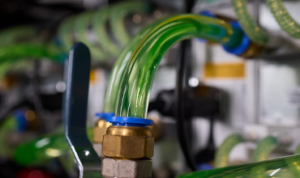Breaking the Efficiency Ceiling: How Next-Gen Cooling Solutions Are Reshaping Thermal Management
 As AI and high-performance computing (HPC) continue to push the boundaries of what’s possible, data centers are being pushed right along with them. Increasing power densities are creating thermal challenges that traditional air cooling systems are no longer equipped to handle. Designed for earlier generations of hardware, these systems are straining under the demand of workloads they were never built to support. The data center industry now finds itself at a turning point—where legacy cooling approaches are fast becoming obsolete, and next-gen alternatives are rising to meet a new era of infrastructure performance.
As AI and high-performance computing (HPC) continue to push the boundaries of what’s possible, data centers are being pushed right along with them. Increasing power densities are creating thermal challenges that traditional air cooling systems are no longer equipped to handle. Designed for earlier generations of hardware, these systems are straining under the demand of workloads they were never built to support. The data center industry now finds itself at a turning point—where legacy cooling approaches are fast becoming obsolete, and next-gen alternatives are rising to meet a new era of infrastructure performance.
The Breaking Point: Why Air Cooling Can’t Keep Up
For years, air cooling has been the default method of thermal management across global data centers. But the dramatic growth in processing power per chip and the increasing density of modern servers are rapidly exposing the shortcomings of this legacy approach. Industry projections suggest that traditional air systems will become insufficient for facilities running AI and HPC workloads as early as 2026. The foundational assumptions of airflow, ambient temperature control, and rack spacing are collapsing under the weight of today’s compute demands.
The latest GPUs and AI accelerators regularly draw more than 700 watts each. In racks densely packed with these components, total thermal output can exceed 50kW—well beyond what most air-cooled systems can reliably manage. In practice, this results in uneven cooling, the formation of hot spots, thermal throttling, and even premature equipment failure. To combat this, operators have been forced to ramp up fan speeds and invest in additional HVAC capacity, which increases power consumption and raises operational costs.
This overreliance on air cooling is also running counter to the industry’s sustainability goals. Cooling can account for up to 40% of a data center’s total energy usage. As power bills climb and regulatory bodies place growing emphasis on carbon reduction, the data center sector is under intensifying pressure to rethink how thermal loads are managed. Simply adding more fans is not a sustainable answer.
Direct-to-Chip Cooling: Hitting Heat at the Source
Direct-to-chip liquid cooling offers a more efficient and targeted alternative to conventional air systems. By placing cold plates directly onto the hottest components—such as CPUs, GPUs, and memory modules—heat is absorbed at the source and carried away via a liquid coolant loop. This heat is then transferred to an external loop, where it can be expelled more efficiently using a heat exchanger or dry cooler.
This technique allows for much greater heat removal per unit of space and supports high-performance workloads without compromising density or reliability. In high-density environments, direct-to-chip cooling enables operators to scale vertically within the same footprint, achieving far greater compute power per rack than air could allow. Beyond thermal efficiency, this approach also reduces the need for excessive airflow, decreasing fan noise and lowering white space energy consumption.
However, the shift to direct-to-chip cooling isn’t without its requirements. Data centers must ensure server platforms are compatible, design systems with fluid management in mind, and account for new infrastructure like manifolds, pump units, and leak detection mechanisms. There is also the capital investment needed to retrofit or build out the system. Still, for many operators, the performance benefits, energy savings, and long-term cost efficiency of direct-to-chip cooling are proving to outweigh the upfront complexities.
Immersion Cooling: Maximum Efficiency Through Submersion
For workloads that push the outer limits of thermal output such as AI training, computational modeling, and real-time analytics, immersion cooling offers a transformative leap in efficiency. Instead of directing cooling agents to individual components, immersion cooling submerges entire servers or boards in dielectric fluids that absorb heat directly from all surfaces. These specialized fluids are non-conductive, allowing power to flow normally while heat is drawn away without the need for airflow or fans.
There are two core types of immersion cooling systems. In single-phase setups, the fluid remains in a liquid state as it circulates through a heat exchanger to release the absorbed heat. In two-phase systems, the fluid boils as it absorbs heat and then condenses back into liquid in a separate chamber, providing even more efficient heat transfer. While two-phase systems are more complex and typically carry higher costs, both approaches offer significant performance gains over air or even direct-to-chip systems, particularly in terms of cooling power, energy use, and hardware protection.
Immersion cooling reduces power consumption by eliminating fans, minimizes the risk of airborne contaminants, and can significantly extend the life of server components. It also allows for extreme rack densities that are impossible to achieve with air cooling. However, immersion cooling requires specialized enclosures, trained staff, and often custom-configured server hardware. It is not a plug-and-play solution—but for operators looking to maximize efficiency and performance, particularly in space-constrained or energy-intensive environments, it represents one of the most advanced solutions available.
Industry Momentum: Who’s Making the Leap?
The transition to liquid cooling is already well underway, led by some of the biggest names in cloud and hyperscale infrastructure. Companies like Microsoft, Google, and AWS are investing heavily in both direct-to-chip and immersion technologies to support their rapidly growing AI and machine learning platforms. These organizations have the scale and resources to pioneer adoption—and their successes are setting benchmarks for the rest of the industry.
Enterprise data centers and edge operators are also beginning to follow suit. As space becomes more expensive and compute density more critical, smaller facilities are discovering that liquid cooling can unlock new performance levels without requiring massive expansions. In regions with high ambient temperatures or energy constraints, immersion cooling in particular is gaining traction as a more sustainable and cost-effective strategy.
On the policy front, governments and regulatory agencies are also playing a role. Efficiency standards are becoming stricter, and sustainability is emerging as a core requirement in new data center builds. Liquid cooling is increasingly viewed not only as an operational upgrade, but as a path toward compliance with evolving environmental regulations and ESG mandates.
Looking Ahead: Intelligent, Integrated, and Future-Proof
The next phase of data center cooling isn’t just about adopting liquid solutions—it’s about integrating them intelligently. Hybrid systems that combine direct-to-chip and immersion technologies are now being developed to adapt dynamically to changing workloads. Using sensor feedback, these systems fine-tune cooling strategies in real time based on thermal load, equipment age, and power constraints.
At the same time, dielectric fluid innovation is advancing rapidly. Fluids enhanced with nanoparticles or fluorinated compounds are improving heat transfer efficiency while maintaining electrical insulation. Originally developed for use in electric vehicles and industrial transformers, these materials are now bringing proven thermal advantages to data center environments.
Artificial intelligence is also reshaping thermal management. Machine learning models analyze data from across the facility to predict cooling needs, detect anomalies, and automatically adjust system performance. This level of real-time optimization reduces energy consumption, improves uptime, and helps operators maintain greater control over increasingly complex infrastructure. As a result, investment across the liquid cooling ecosystem is accelerating—paving the way for a future where liquid is the default, not the exception.
Airedale by Modine: Built for What’s Next
As traditional cooling systems struggle to keep pace, the data center industry is shifting toward solutions designed for today’s high-performance workloads. Direct-to-chip and immersion cooling are no longer niche—they’re becoming essential for operators focused on performance, scalability, and sustainability.
While many providers attempt to adapt outdated technologies to modern challenges, Airedale by Modine is building for what’s next. Through tailored thermal solutions, deep engineering expertise, and a commitment to innovation, Airedale is helping data centers achieve next-generation efficiency and resilience.
Connect with us to explore how our advanced cooling systems can position your operation to meet rising thermal demands—and prepare for the data center of tomorrow.





